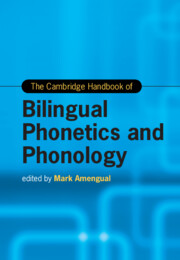Book contents
- The Cambridge Handbook of Bilingual Phonetics and Phonology
- Cambridge Handbooks in Language and Linguistics
- The Cambridge Handbook of Bilingual Phonetics and Phonology
- Copyright page
- Dedication
- Contents
- Figures
- Tables
- Contributors
- Acknowledgments
- Introduction Bilingual Phonetics and Phonology
- Part I Approaches to Bilingual Phonetics and Phonology
- Part II Theoretical Models of Bilingual Phonetics and Phonology
- Part III The Phonetics and Phonology of the Bilingual Child
- 12 The Speech Perception of Bilingual Infants
- 13 The Speech Production of Bilingual Children
- 14 Phonological Disorders in Child Bilingualism
- 15 Acquisition of Segmental Phonology in Child Bilingualism
- 16 Acquisition of Suprasegmental Phonology in Child Bilingualism
- Part IV The Phonetics and Phonology of the Bilingual Adult
- Part V The Diversity of Bilingual Speakers
- Part VI Variables and Outcomes of Bilingual Speech
- Index
- References
16 - Acquisition of Suprasegmental Phonology in Child Bilingualism
from Part III - The Phonetics and Phonology of the Bilingual Child
Published online by Cambridge University Press: 14 November 2024
- The Cambridge Handbook of Bilingual Phonetics and Phonology
- Cambridge Handbooks in Language and Linguistics
- The Cambridge Handbook of Bilingual Phonetics and Phonology
- Copyright page
- Dedication
- Contents
- Figures
- Tables
- Contributors
- Acknowledgments
- Introduction Bilingual Phonetics and Phonology
- Part I Approaches to Bilingual Phonetics and Phonology
- Part II Theoretical Models of Bilingual Phonetics and Phonology
- Part III The Phonetics and Phonology of the Bilingual Child
- 12 The Speech Perception of Bilingual Infants
- 13 The Speech Production of Bilingual Children
- 14 Phonological Disorders in Child Bilingualism
- 15 Acquisition of Segmental Phonology in Child Bilingualism
- 16 Acquisition of Suprasegmental Phonology in Child Bilingualism
- Part IV The Phonetics and Phonology of the Bilingual Adult
- Part V The Diversity of Bilingual Speakers
- Part VI Variables and Outcomes of Bilingual Speech
- Index
- References
Summary
The aim of this chapter is to provide the state-of-the-art of the research on the development of suprasegmental phonology in bilingual children from infancy through childhood. First, we discuss word-level prosodic phenomena, with a special focus on the bilingual acquisition of word stress and syllable structure, which has been a lively area of research. We also present recent data on the acquisition of tone, which remains a less investigated topic. Second, we consider the acquisition of phrase-level prosody, namely, rhythm and intonation. For each domain of prosodic development, we briefly review monolingual patterns and discuss how learning two (or more) phonological systems can affect developmental trajectories, showing that there can be different cross-linguistic interactions such as transfer, delay, acceleration, or fusion. We also consider potential influencing factors that can trigger different tracks in the development of prosody, for example age of onset, amount of exposure, language dominance, and simultaneous or sequential language acquisition. The chapter concludes with a discussion of avenues for future research.
- Type
- Chapter
- Information
- The Cambridge Handbook of Bilingual Phonetics and Phonology , pp. 359 - 382Publisher: Cambridge University PressPrint publication year: 2024

